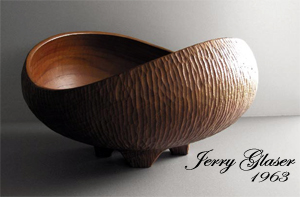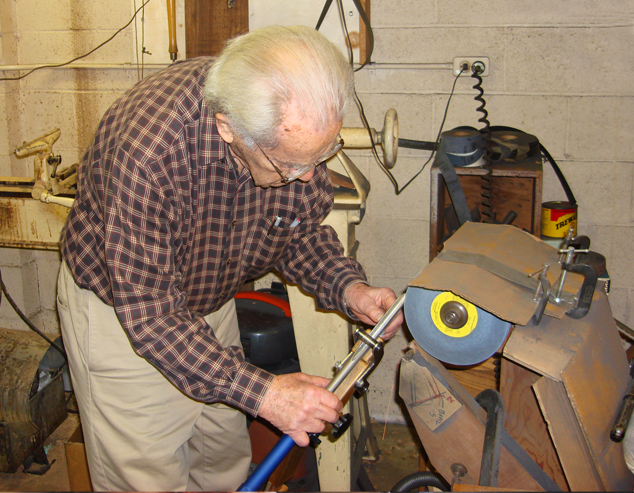 Close your eyes and imagine a bowl with a sculpted rim, a finely textured outside, and carved feet. Although this sounds contemporary, now imagine this piece featured in a major California art show in 1963. Few people know that his woodturnings appeared in major shows in the late 1950s and early 1960s.
Close your eyes and imagine a bowl with a sculpted rim, a finely textured outside, and carved feet. Although this sounds contemporary, now imagine this piece featured in a major California art show in 1963. Few people know that his woodturnings appeared in major shows in the late 1950s and early 1960s.
In the late 1930s, Jerry attended an exhibition of Swedish crafts at Marshall Field’s in Chicago. In that show, he saw bowls with sculpted rims—evocative of natural edge bowls that his friend Bob Stocksdale would make famous years later. “What impressed me were the turned bowls that had the undulating curved form on the edges, “says Jerry. I tried to incorporate this shape in my work much later on.”
 In the early 1950s, Jerry was set to pursue turning in a serious manner. He purchased an Oliver lathe for $75 at an auction and found a California supplier of exotic hardwoods. He was an invited artist in a number of West Coast shows. The “California Design Eight” in 1964 chronicles Jerry’s stature. The show included five pieces from Jerry, six Bob Stocksdale turnings, and several Sam Maloof furniture pieces.
In the early 1950s, Jerry was set to pursue turning in a serious manner. He purchased an Oliver lathe for $75 at an auction and found a California supplier of exotic hardwoods. He was an invited artist in a number of West Coast shows. The “California Design Eight” in 1964 chronicles Jerry’s stature. The show included five pieces from Jerry, six Bob Stocksdale turnings, and several Sam Maloof furniture pieces.
Prices tell a story: A Glaser cocobolo bowl was priced at $50, a Stocksdale lignum vitae bowl went for $18, and a Maloof side table had a $350 price tag. Jerry saw bowls with sculpted rims—evocative of natural edge bowls that his friend Bob Stocksdale would make famous years later. “What impressed me were the turned bowls that had the undulating curved form on the edges, “says Jerry. I tried to incorporate this shape in my work much later on.” Jerry’s work from that period looks like it could fit comfortably into a 2006 exhibition.
 The sculpted rims, bowls with texture on the outside—shallow carved scallops to add interest—and the carved feet all can be seen in work being done today.
The sculpted rims, bowls with texture on the outside—shallow carved scallops to add interest—and the carved feet all can be seen in work being done today.
The carved feet were Jerry’s solution to screws from his lathe chuck. “I just carved away the area with the holes, and what was left became feet,” Jerry recalls. More than one woodturner has pointed out he or she has seen examples of Jerry’s turning in books printed in the late ‘50s through the ‘70s. Design books, exhibition catalogues, and technique books have examples of Jerry’s woodturning.
At the early stage of his woodturning career, Jerry was already poised to become a well renowned craftsman. Little did Jerry know, he would also be known for his grand contributions to the evolution of woodturning tools. His exceptional ideas coupled with his cutting-edge advances in steel tooling ultimately allowed him create what many regard as the finest woodturning tool in the world.

